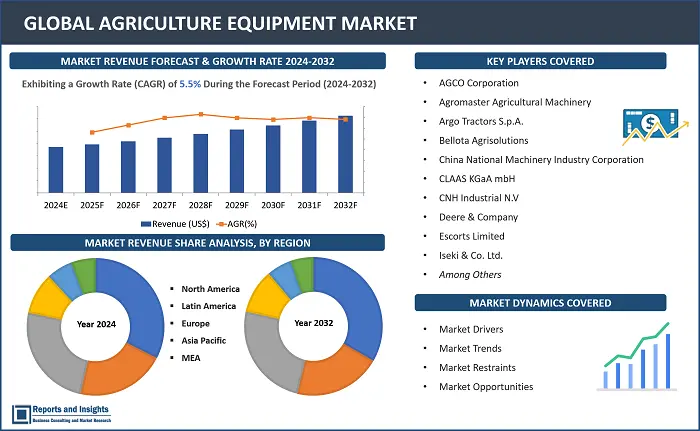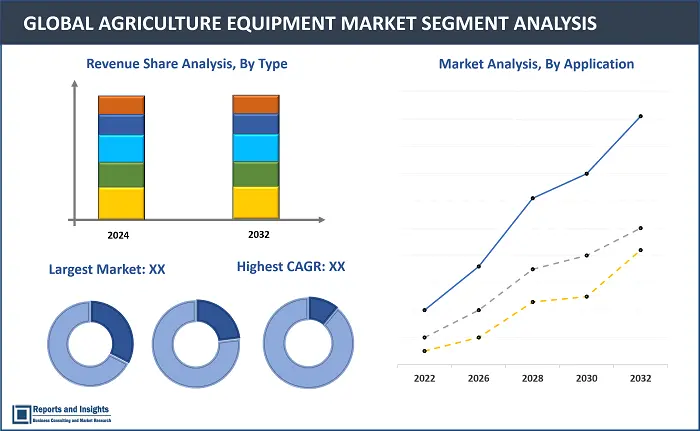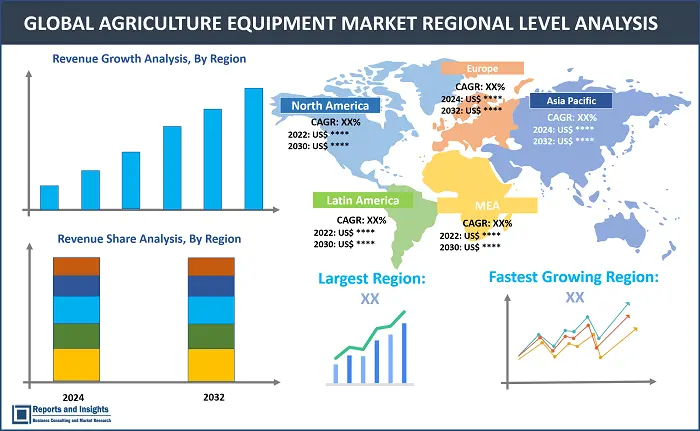Market Overview:
"The agriculture equipment market size reached USD 170.8 billion in 2023. Looking forward, Reports and Insights expects the market to reach USD 276.54 billion by 2032, exhibiting a growth rate (CAGR) of 5.5% during 2024-2032."
|
Report Attributes |
Details |
|
Base Year |
2023 |
|
Forecast Years |
2024-2032 |
|
Historical Years |
2021-2023 |
|
Market Growth Rate (2024-2032) |
5.5% |
Agricultural equipment encompasses a diverse array of machinery and tools designed to improve efficiency and productivity in farming operations. These devices serve various purposes, including plowing, planting, harvesting, and irrigation, with the goal of streamlining agricultural processes. Examples include tractors, combines, plows, seeders, and irrigation systems. Incorporating advanced technologies like GPS guidance, sensors, and automation, modern agricultural equipment aims to optimize precision and resource usage. The ongoing evolution of agricultural equipment plays a crucial role in transforming traditional farming practices, contributing to increased output, sustainability, and overall innovation in agriculture.
The agricultural equipment market is undergoing dynamic growth, adapting to the changing demands of contemporary farming practices. It encompasses a diverse range of machinery and tools aimed at improving efficiency in agricultural operations, including tractors, combines, plows, seeders, and irrigation systems. Factors such as the increasing trend toward mechanization, the integration of advanced technologies like GPS guidance and automation, and the growing emphasis on precision farming contribute to the expansion of this market. As agriculture evolves to meet the challenges of global food demand and sustainability, manufacturers in the agricultural equipment market are focusing on innovation, striving to develop more sophisticated and technologically advanced solutions to address the evolving needs of farmers worldwide.

Agriculture Equipment Market Trends and Drivers
The agriculture equipment market is undergoing significant shifts driven by transformative trends and key drivers. Precision farming, fueled by advancements in GPS technology and automation, is a prominent trend, optimizing resource usage and boosting crop yields. The integration of IoT devices and sensors into agricultural machinery serves as a major driver, facilitating real-time data collection for enhanced decision-making. The market is also witnessing a surge in demand for eco-friendly and energy-efficient equipment, aligning with the growing emphasis on sustainable agriculture practices. Moreover, the adoption of autonomous machinery, combined with the incorporation of data analytics and artificial intelligence, is reshaping traditional farming methods. Amidst global concerns about food security, the need to modernize farming practices, and the impact of climate change, the agriculture equipment market is characterized by a dynamic landscape that prioritizes innovation and operational efficiency.
Agriculture Equipment Market Restraining Factors
Despite the optimistic growth prospects in the agriculture equipment market, there are several factors constraining its expansion. Substantial upfront costs associated with acquiring advanced machinery and technology present a notable barrier, particularly for smaller-scale farmers. The inherent unpredictability of weather conditions and environmental factors poses challenges to the consistent performance of agricultural equipment. Limited access to credit in developing regions further impedes farmers' capacity to invest in modern equipment. The existing skills gap in adopting and managing sophisticated technologies adds to the challenges, with many farmers lacking the requisite training. Additionally, the fluctuation of commodity prices and economic uncertainties contribute to a cautious approach in investing in new agricultural equipment. Mitigating these constraining factors is essential to facilitate widespread adoption and ensure the sustainable development of the agriculture equipment market.
Agriculture Equipment Market Opportunities
Opportunities abound in the agriculture equipment market driven by diverse factors. The increasing global demand for food and the necessity for heightened agricultural productivity provide a favorable backdrop for the advancement and adoption of innovative equipment and technologies. Precision agriculture, incorporating state-of-the-art tools such as GPS, sensors, and automation, holds considerable promise for optimizing resource utilization and elevating crop yields. The escalating focus on sustainable and eco-friendly farming practices creates avenues for the development of energy-efficient and environmentally conscious agricultural equipment. Additionally, the widespread adoption of smart farming technologies, including the integration of IoT devices and data analytics, allows manufacturers to offer more sophisticated and interconnected solutions. Collaborative efforts between technology providers and agricultural stakeholders, coupled with supportive government initiatives promoting agricultural modernization, further contribute to the positive landscape of opportunities in the agriculture equipment market.
Agriculture Equipment Market Segmentation

By Type
- Tractors
- Harvesters
- Soil Preparation and Cultivation
- Irrigation and Crop Processing
- Agriculture Spraying Equipment
- Hay and Forage Machines
- Others
The agricultural machinery sector is divided into distinct types, each fulfilling specific roles in farming processes. Tractors are integral for providing power across various tasks, while harvesters play a crucial role in efficient crop harvesting. Equipment for soil preparation and cultivation is designed for activities like plowing and seeding. Irrigation and crop processing machinery ensure optimal water supply and aid in crop processing. Agriculture spraying equipment is utilized for pest control and fertilization, and hay and forage machines assist in harvesting and processing forage crops. The "Others" category encompasses a variety of specialized agricultural machinery addressing diverse farming needs. Collectively, these segments contribute to the modernization and streamlining of agricultural practices, enhancing efficiency and productivity in the continually evolving field of farming.
By Application
- Land Development
- Sowing & Planting
- Threshing and Harvesting
- Plant Protection
- After Agro Processing
When classified based on their applications, the agricultural machinery segment encompasses pivotal roles in various stages of the farming process. Equipment dedicated to land development is essential for preparing fields and optimizing soil conditions. Sowing and planting machinery ensures precision and efficiency in crop seeding, while threshing and harvesting equipment play a vital role in the extraction of grains and crops at the culmination of the growing cycle. Plant protection tools, including spraying equipment, contribute to safeguarding crops against pests and diseases. Machinery designed for after-agro processing is involved in post-harvest activities, ensuring the effective handling and processing of crops. Each subcategory within this application-based segmentation addresses specific phases of the agricultural cycle, collectively contributing to the progress and refinement of global farming practices.
By Automation
- Manual
- Semi-Automatic
- Automatic
The automation classification within the agricultural machinery sector includes three categories: manual, semi-automatic, and automatic. Manual machinery relies on direct human intervention, requiring hands-on control and physical effort. Semi-automatic equipment represents an intermediate level of automation, integrating both human input and automated processes to improve efficiency. In contrast, automatic machinery operates with minimal human intervention, utilizing advanced technologies for autonomous functionality. This range of automation options provides a flexible approach to address various farming needs, spanning from hands-on control to advanced, technology-driven solutions, reflecting the dynamic nature of agricultural mechanization.
By Region

North America
- United States
- Canada
Europe
- Germany
- United Kingdom
- France
- Italy
- Spain
- Russia
- Poland
- Benelux
- Nordic
- Rest of Europe
Asia Pacific
- China
- Japan
- India
- South Korea
- ASEAN
- Australia & New Zealand
- Rest of Asia Pacific
Latin America
- Brazil
- Mexico
- Argentina
Middle East & Africa
- Saudi Arabia
- South Africa
- United Arab Emirates
- Israel
- Rest of MEA
The segmentation of the agriculture equipment market by region includes North America, Europe, Asia Pacific, Latin America, and the Middle East and Africa. In North America, a highly advanced agricultural sector fuels the demand for cutting-edge equipment, particularly emphasizing precision farming. Europe demonstrates a growing preference for sustainable and intelligent farming practices, fostering the uptake of innovative agricultural machinery. The Asia Pacific region, with its expansive and varied agricultural terrain, experiences a rising demand for efficient and scalable equipment to address the needs of a burgeoning population. Latin America underscores the significance of agriculture as a primary economic driver, propelling the requirement for advanced equipment to enhance productivity. In the Middle East and Africa, endeavors to overcome challenges such as water scarcity and climatic conditions drive the adoption of customized agricultural machinery. The distinctive agricultural landscapes and challenges in each region contribute to the varied demands and opportunities within the global agriculture equipment market.
Leading Agricultural Equipment Manufacturers & Competitive Landscape:
The agricultural equipment market is highly competitive, with several key players vying for market share and actively engaging in strategic initiatives. These companies focus on product innovation, technological advancements, and expanding their product portfolios to gain a competitive edge. These companies are continuously investing in research and development activities to enhance their product offerings and cater to the evolving needs of customers in terms of efficiency, performance, and sustainability.
These companies include:
- AGCO Corporation
- Agromaster Agricultural Machinery
- Argo Tractors S.p.A.
- Bellota Agrisolutions
- China National Machinery Industry Corporation
- CLAAS KGaA mbH
- CNH Industrial N.V
- Deere & Company
- Escorts Limited
- Iseki & Co. Ltd.
- JC Bamford Excavators Ltd
- Kubota Corporation
- Mahindra & Mahindra Limited and SDF Group
Recent Development:
- November 2023: Paras Aerospace, a drone manufacturer, plans to venture into providing agricultural services, including spraying and seeding, in the upcoming fiscal year.
Market Research Scope
|
Report Metric |
Report Details |
|
Market size available for the years |
2021-2023 |
|
Base Year |
2023 |
|
Forecast Period |
2024-2032 |
|
Compound Annual Growth Rate (CAGR) |
5.5% |
|
Segment covered |
Type, application, automation and regions. |
|
Regions Covered |
North America: The U.S. & Canada Latin America: Brazil, Mexico, Argentina, & Rest of Latin America Asia Pacific: China, India, Japan, Australia & New Zealand, ASEAN, & Rest of Asia Pacific Europe: Germany, The U.K., France, Spain, Italy, Russia, Poland, BENELUX, NORDIC, & Rest of Europe The Middle East & Africa: Saudi Arabia, United Arab Emirates, South Africa, Egypt, Israel, and Rest of MEA |
|
Fastest Growing Country in Europe |
Germany |
|
Largest Market |
Asia Pacific |
|
Key Players |
AGCO Corporation, Agromaster Agricultural Machinery, Argo Tractors S.p.A., Bellota Agrisolutions, China National Machinery Industry Corporation, CLAAS KGaA mbH, CNH Industrial N.V., Deere & Company, Escorts Limited, Iseki & Co. Ltd., JC Bamford Excavators Ltd., Kubota Corporation, Mahindra & Mahindra Limited and SDF Group. |
Frequently Asked Question
What is the market size of agricultural equipment market in the year 2023?
The agricultural equipment market size reached USD 170.8 billion in 2023
What are some key factors driving revenue growth of the agricultural equipment market?
Some key factors driving agricultural equipment market revenue growth include technological advancements, global population growth and government initiatives.
What are some major challenges faced by companies in the agricultural equipment market?
Companies face challenges such as high initial costs, rural infrastructure, environmental concerns and market fragmentation.
How is the competitive landscape in the global agricultural equipment market?
The market is competitive, with key players focusing on technological advancements, product innovation, and strategic partnerships. Factors such as product quality, reliability, after-sales services, and customization capabilities play a significant role in determining competitiveness.
Which region has the biggest market share in agricultural equipment market?
Asia Pacific has the biggest market share in agricultural equipment market.
At what CAGR will the agricultural equipment market expand?
The market is anticipated to rise at 5.5% CAGR.
How is the agricultural equipment market segmented?
The market is segmented based on type, application, automation, and regions.
What are the key players in agricultural equipment market?
The key players in agricultural equipment market include AGCO Corporation, Agromaster Agricultural Machinery, Argo Tractors S.p.A., Bellota Agrisolutions, China National Machinery Industry Corporation, CLAAS KGaA mbH, CNH Industrial N.V., Deere & Company, Escorts Limited, Iseki & Co. Ltd., JC Bamford Excavators Ltd., Kubota Corporation, Mahindra & Mahindra Limited and SDF Group.
